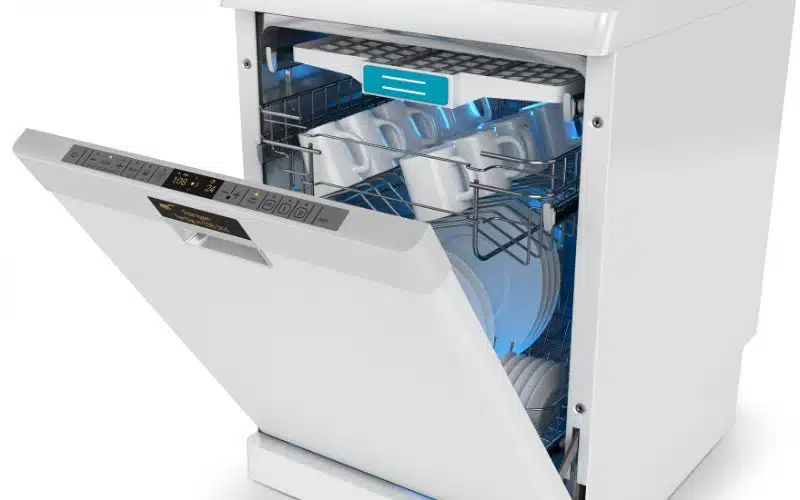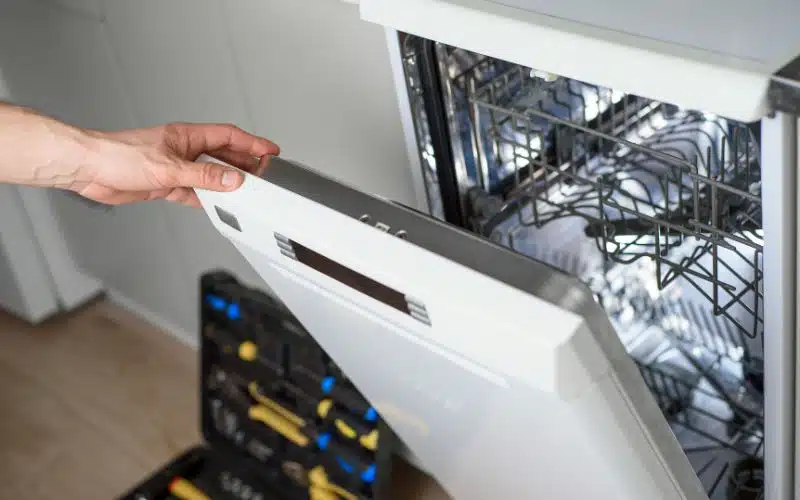Like all home appliances, the dishwasher is a vital part of most houses. Your dishwasher helps ease the stress of manual dishwashing both at home and in commercial environments.
Therefore, it is necessary to see the good working condition of your dishwasher to ensure its long lifespan.
Most appliances are prone to specific faults once in a while, your dishwasher inclusive. One typical complaint from most people is the presence of pinkish mold growth in their dishwashers.
The pink mold in your dishwasher is evidence of bacteria growth. The pink mold-causing bacteria is known as Serratia marcescens. The damp environment of the dishwasher provides a suitable environment for the growth of bacteria. In addition, other factors such as the absence of light and food residue promote mold growth.
Why Does Pink Mold Grow in Dishwashers?

A dishwasher is a place that is usually moist; this makes it an ideal environment for mold growth. Serratia marcescens bacteria is known to grow best in such wet environments.
However, you can have a mold-free dishwasher if you maintain it properly. Other conditions that contribute to the growth of pink mold in the dishwasher are:
#1. Heat/Temperature
The required temperature of the dishwasher should be able to prevent mold growth.
However, this temperature is not always constant; once excess heat sets in, it becomes suitable for mold growth.
The heat is usually a result of warm air getting in by letting the dishwasher’s door sit open for a long time.
#2. Moisture
The nature of the dishwasher makes it wet most time. Bacteria favor moist environments to grow, such as your toilets.
#3. Food Remnant
Most people just put greasy plates into the dishwasher without pre-washing. The food residue, in turn, becomes food for the bacteria to feed on and grow.
#4. The absence of Light
Darkness is another factor that supports pink mold growth in your dishwasher. Serratia marcescens thrive in the darkness that your dishwasher provides.
How Do I Get Rid Of Pink Mold in My Dishwasher?
You can eradicate pink mold from your dishwasher. Noticing it at its early stage is sometimes hard, but if you do, you can’t let it grow further. You must follow some processes to eliminate this mold in your dishwasher.
When you tackle mold growth in your dishwasher, everything else falls under three basic steps: disinfecting, cleaning, and ventilating.
Here’s how:
#1. By Using Chlorine Bleach
Some people don’t fancy using bleach because of its extreme harshness; however, it is an effective mold remover.
Make a bleach solution in water with a bristle brush and scrub your dishwasher. Ensure the brush reaches all crevices in the dishwasher and scrub thoroughly.
After scrubbing, rinse it by running a regular cycle for the machine. Keep the door of the machine open, so it’ll dry out.
You can use a clean, dry rag to dry out the places that take time to get dry. You must note that the use of bleach might cause damage to certain parts of your dishwasher.
#2. With Baking Soda And Vinegar
These everyday household items are the usual go-to for cleaning mold in dishwashers. Make a foamy mixture of your vinegar and baking soda.
Get a firm brush and use the mixture to scrub the dishwasher; ensure you scrub every corner of the machine properly.
Spray undiluted vinegar inside the dishwasher and run a normal cycle to rinse. Leave the machine door open to dry out.
Alternatively, you can pour the baking soda at the bottom of the dishwasher and keep a bowl of white vinegar on the top rack.
Close the door firmly and run a hot water cycle; run a regular cycle to rinse. The method will provide the desired effect of thoroughly removing mold.
There’s an alternative way of using vinegar, especially if you are without baking soda. All you have to do is get a cup of white vinegar and pour it into the dishwasher.
Next, you run the hottest cycle of the dishwasher for some time. Finally, rinse with a regular cycle and leave the machine open to dry.
#3. Using Lemon Juice
One significant advantage of lemon juice is its ability to remove the foul moldy odor and leave behind a citrusy fragrance.
To use the juice, pour a little quantity into a container and keep it on the bottom of your machine.
Then, close the door and run a regular cycle; your dishwasher will be mold free in no time.
#4. Dishwasher Parts Affected By Mold And How To Remove them:
| Parts | Solution |
|---|---|
| Filter | Firstly, you run it under hot water. Then, delicately use a sponge and scrub it using detergent. |
| Gasket (rubber seal on the door) | Use a stiff brush and scrub it with a vinegar-baking soda mixture. You can opt for an all-purpose cleaner instead. |
| Drain hose | Thoroughly scrub it with a stiff brush using a chlorine-based detergent. |
Vinegar is very effective in removing mold and other residues in your dishwasher; it is also a good disinfectant.
After the cleaning methods mentioned above, it is necessary to disinfect your dishwasher. The disinfection kills any residue of mold left.
Before cleaning your dishwasher, you must put on protective materials such as gloves, goggles, and a facemask.
When cleaning, ensure the room is well ventilated; this will facilitate the machine drying faster.
If the mold seems to be beyond you, for example, it covers ten square feet and above; it would be best to call professional cleaning services that deal with dishwashers to handle it.
How Do I Stop Mold From Growing in My Dishwasher?
Preventing mold growth is more accessible than the stress of getting it out. Maintenance is key to keeping any machine in good working condition; therefore, good maintenance prevents mold growth.
Simple ways to prevent/stop mold growth are:
- It will help if you rinse your dishes before putting them in the dishwasher. Not pre-washing gets food debris into the machine, which feeds mold.
- Clean and dry out your dishwasher after using it. Deep clean it in two months.
- Regular use of detergent and regular sanitizing is also necessary.
- Your dishwasher shouldn’t be close to appliances that give out cold air like refrigerators.
- Don’t allow dirty plates to stay in the dishwasher for an extended period.
- Run your empty machine once weekly on a regular cycle.
- Occasionally clean removable parts of the dishwasher like the racks and utensil holder. Use an all-purpose cleaner for general cleaning of the dishwasher.
- Ensure to clean the machine door regularly. Leave it slightly open when not in use to aid ventilation.
- The rubber parts of the dishwasher are susceptible to mold growth, for example, the rubber seal on the door. Therefore, ensure to clean them as often as possible properly.
- Let your dishwasher door open after any cleaning to dry appropriately. Use absorbent rags to clean the Moisture where necessary.
- Get professionals to annually service and clean the machine.
Is Pink Mold Harmful?
Yes! Exposure to pink mold can be harmful to human health. The mold triggers allergic reactions in some sensitive people. Generally, it is not wise to leave machines infested with mold growth.
Sensitivity to mold usually causes coughing, skin or eye irritation, rashes, throat inflammation, and sneezing and triggers other respiratory difficulties like asthma.
In addition, people with weak immunity are at greater risk due to pink mold exposure.
Pink mold is more harmful to those with health issues. However, even healthy people stand a risk of getting some mold-related side effects.
Avoiding all this easier by preventing pink mold growth in your household is easier. If you experience it anyways, ensure you deal with it with maximum effect.
Is It Safe to Use a Moldy Dishwasher?
No! It is in no way safe to use a moldy dishwasher. The side effects of mold are too numerous to stay ignored.
If you have a moldy dishwasher and stubbornly or ignorantly use it, the mold is sure to get on the dishes.
When fragments of this mold get into utensils you make use of to cook, your entire family stands a risk of different types.
The function of the dishwasher is to keep dishes clean; a moldy dishwasher will dispense bacteria on those dishes.
The dishes may look clean after using the moldy machine, but the amount of bacteria on them is alarming.
In addition, older people and small children have fragile immunities and face a greater risk from this mold’s side effects.
Exposure to mold leads to a variety of health issues and allergic reactions. Therefore, it is wise to take precautionary measures to prevent mold.
Once you discover your dishwasher has a mold problem, get rid of it quickly. Removing mold will significantly ensure personal and family safety; it boosts the machine’s functionality.
Final Thoughts
Pink mold growth in your dishwasher is unpleasant and detrimental to health. The natural conditions of your dishwasher make an ideal breeding environment for mold, but you can prevent it by taking precautions.
Of course, you can always get professional help if you can’t handle the mold independently.





